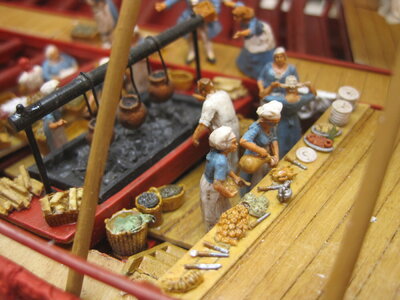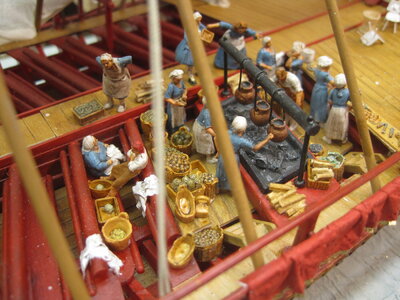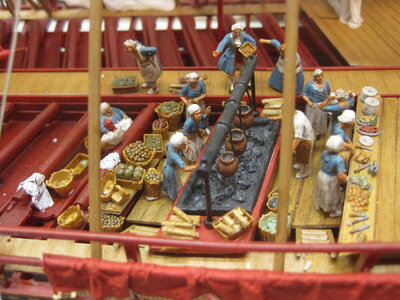-

Win a Free Custom Engraved Brass Coin!!!
As a way to introduce our brass coins to the community, we will raffle off a free coin during the month of August. Follow link ABOVE for instructions for entering.
-

PRE-ORDER SHIPS IN SCALE TODAY!
The beloved Ships in Scale Magazine is back and charting a new course for 2026!
Discover new skills, new techniques, and new inspirations in every issue.
NOTE THAT OUR FIRST ISSUE WILL BE JAN/FEB 2026
You are using an out of date browser. It may not display this or other websites correctly.
You should upgrade or use an alternative browser.
You should upgrade or use an alternative browser.
"La Reale" (Heller), converted for a Galley Festival
It was not easy to build an awning, the upper edge of which forms a harmonious line, as can be seen in contemporary illustrations, even if they are somewhat idealized. The structure of the scaffolding consists of wooden sticks with a diameter of 2 mm. Less was measured than tried and discarded and tried again. The awning itself is made of paper handkerchief that has been treated with a mixture of white glue and water. The handkerchief is roughly cut and moistened in place. The process is very delicate because the material tends to tear when treated carelessly or with a too sharp tool. I was genuinely surprised that no particular disasters happened. But then there was one, because when I wanted to paint the awning after it was dry, ugly dirty clouds appeared on the inside, which did not disappear through several coats of paint. So I set up a lab for model awnings and found that I could solve the problem by adding wall paint and Earl Gray tea to the glue-water mixture. Thus the dried sail no longer needs to be painted and has a uniform color. Here some pictures of the process:
Building up the first awning. Everything seemed fine.
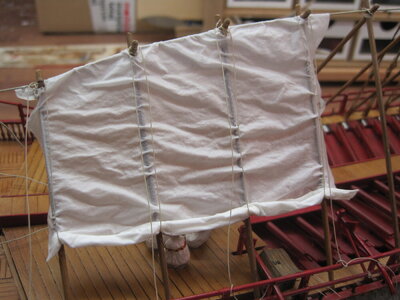
But then, after painting, the ugly clouds appeared on the inside. God knows why.
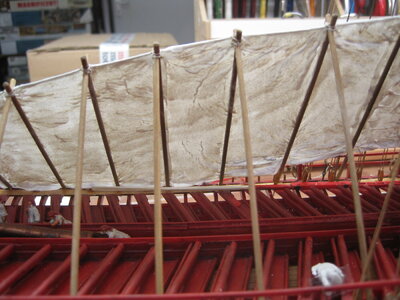
Nothing to see from the outside. A miracle, but not a good one.
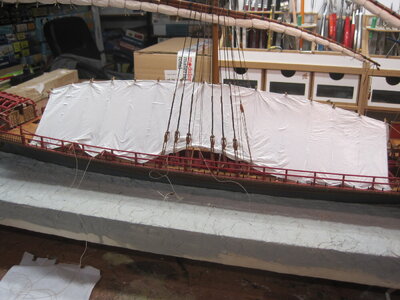
Because I could not stand the clouds (on the awning), I broke everything. No fun either, for the handkerchief awning stuck to the supports an I had to build up everything for a second time.
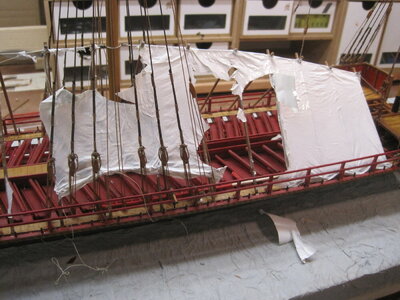
This is my paper awning lab in which I tested several mixtures of glue, water, colour and tea, until I found out that an addition of wall colour was the solution.
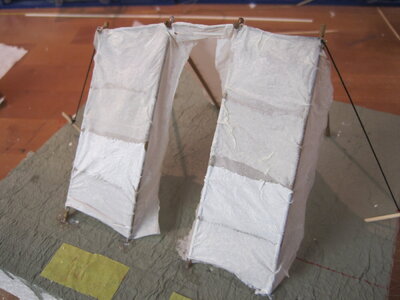
Two pictures of the second awning, without clouds but with my complete satisfaction.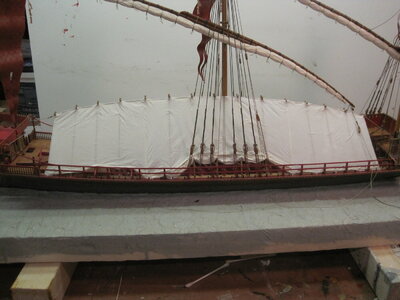
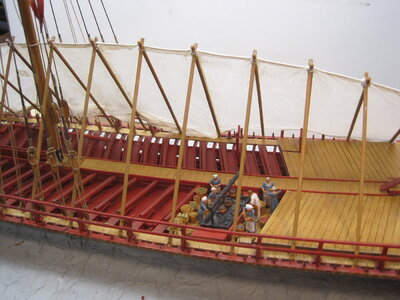
Building up the first awning. Everything seemed fine.

But then, after painting, the ugly clouds appeared on the inside. God knows why.

Nothing to see from the outside. A miracle, but not a good one.

Because I could not stand the clouds (on the awning), I broke everything. No fun either, for the handkerchief awning stuck to the supports an I had to build up everything for a second time.

This is my paper awning lab in which I tested several mixtures of glue, water, colour and tea, until I found out that an addition of wall colour was the solution.

Two pictures of the second awning, without clouds but with my complete satisfaction.


Last edited:
Looking very good - great idea to add these details  They are making this model to a very special model
They are making this model to a very special model
- Joined
- Nov 16, 2019
- Messages
- 29
- Points
- 78

Superbe, félicitations
Francis
Francis
Good day,
All these modification and details looks great!
Thanks for information about how to make and paint awning!
All the Best!
Kirill
All these modification and details looks great!
Thanks for information about how to make and paint awning!
All the Best!
Kirill
Forgive me if I’ve missed this, somewhere, but where did you source your figures from? Did you have to modify their dress? They look very good, indeed, Schmidt - as do all of your other modifications. The awning is an especially fascinating detail!
The female figures all come from the Preiser set "Medieval Market". I only had to make their headdresses al little smaller. The dresses I could leave as they were. The scullion on the left side is a slightly modified figure from the Preiser set "Sitting Travellers". I glattend the surface of the modern clothing und painted the forearmes and the lower legs with flesh paint. The skirting is made from paper, the head got a headscarf from magic slulp. The chiefs of the catering team on the runway are former carnival prince and princess, without transformation, just painted.
Schmidt
Schmidt
Ahhh, interesting! Thank you for your detailed reply!
Hallo @SchmidtOn the tour through my model ship world, I showed the galley “La Reale”, alongside the “Soleil Royal” and the “Chebec”, one of the flagship models of the French company Heller from the seventies. I built the model about ten years ago, and since then I have actually managed to save the extremely fragile ship undamaged through several moves. In the meantime, however, I've seen myself a little fed up with it, and while researching the Internet, I had an idea for a far-reaching modification. Here one picture of the finished model again.
And here are two contemporary images showing comparable ships in port. They have put up sunsails or nightsails, which I find extremely decorative.
And here are two pictures that show a so-called Galley Festival (Fête de Galeres). That was certainly not an amusement for the poor galley convicts, but partys for an aristocratic audience. In fact, around 1700 the galleys were less of an effective weapon and more of a kind of royal yacht fleet, which is especially true for the "Real" as their flagship, whose ornaments were designed by a famous sculpturer. From these illustrations and further research I have drawn some suggestions that I would now like to implement.
The first change is that I put self-made windows in the structure at the rear. There are models for this in historical illustrations and plans. In my eyes, the structure looks more closed and somehow more homely.
Built oob:
Modifikation:
To be continued.
Schmidt
we wish you all the BEST and a HAPPY BIRTHDAY

I took a creative pause in the outfitting of the galley. By no means is the work abandoned! Here follows some progress.
A member of the "free" crew takes care of spreading the decorative cloths hanging over the lower part of the railing.

This is the rhythm section that provides the steady rowing beat on the galley. Borrowed from Preiser Carnival figures. They are people of dark skin color from the factory. This is not politically correct by today's standards, but it is historically correct, since some of the rowing slaves came from Africa, from where they were abducted. This also happened the other way around with the Berber pirates, but that doesn't make things any better. Whether the rhythm section is supposed to give the illustrious guests a taste of twentieth-century jazz, I don't know. Perhaps there is also a dry-rudder exercise for members of the upper classes.

I made the mistake for a while of making figures first and then seeing where I could place them. That's a gross mistake, running the risk of making too much work and ending up with painstakingly reknitted Preisers retired. It's better to develop the scenes in your head beforehand and then get the appropriate personnel for them. Practically like in the movies.
This relocated cowboy rider fits very nicely on the big rod.

This sailor attaches a new flag line.

Now it's time again for a big scene.
In order to emphasize the highly problematic character of these aesthetically pleasing ships, I have brought aboard, or rather left aboard, a part of the forced crew. Their production was costly. They are all "sitters" made by the Preiser company. The superficial features of their modern clothing have been sanded off, the lower part of their legs and arms completely exposed. Around their heads they wear cloths of putty or impasto wall paint. The painting is as simple as it is uniform. I was less interested in creating individual cultural masterpieces than in producing an ensemble that shows a certain inner dynamism.

I have tentatively made visible the chains on which these poor people lay day and night, so that they would not run away or simply fall upon the crew.

The scene also refers to passages from the only book that has come down to us from one of the galley convicts (Jean Martheile). The young Protestant, who was sentenced to life in the galleys at the age of sixteen, describes how he and his fellow believers were constantly subjected to attempts at conversion. The agitators in question come from Preiser's medieval market and did not need to be awkwardly reshaped. Perhaps they will succeed in presenting a converted Protestant as a special attraction at the beginning of the galley festival. The overseer with the whip also comes from the medieval market.

I put a lot of effort into the oars ten years ago, when I was just starting to cast resin parts. Now these special pieces of jewelry of the first version go from the ship. At least I'm having two crew members do it, so you can see at least a little bit of the remodeled oars. Also, the diagonal of the large oar creates a visual link between the two large (and very different) scenes. Possibly a few more oars will be stored on trestles in the background.

Opening the walkway revealed the rails, which the Heller designers had correctly shown there, with no indication in the build instructions that you could show the big gun in the retracted position. That's what I'm doing now.

To be continued!
Schmidt
A member of the "free" crew takes care of spreading the decorative cloths hanging over the lower part of the railing.

This is the rhythm section that provides the steady rowing beat on the galley. Borrowed from Preiser Carnival figures. They are people of dark skin color from the factory. This is not politically correct by today's standards, but it is historically correct, since some of the rowing slaves came from Africa, from where they were abducted. This also happened the other way around with the Berber pirates, but that doesn't make things any better. Whether the rhythm section is supposed to give the illustrious guests a taste of twentieth-century jazz, I don't know. Perhaps there is also a dry-rudder exercise for members of the upper classes.

I made the mistake for a while of making figures first and then seeing where I could place them. That's a gross mistake, running the risk of making too much work and ending up with painstakingly reknitted Preisers retired. It's better to develop the scenes in your head beforehand and then get the appropriate personnel for them. Practically like in the movies.
This relocated cowboy rider fits very nicely on the big rod.

This sailor attaches a new flag line.

Now it's time again for a big scene.
In order to emphasize the highly problematic character of these aesthetically pleasing ships, I have brought aboard, or rather left aboard, a part of the forced crew. Their production was costly. They are all "sitters" made by the Preiser company. The superficial features of their modern clothing have been sanded off, the lower part of their legs and arms completely exposed. Around their heads they wear cloths of putty or impasto wall paint. The painting is as simple as it is uniform. I was less interested in creating individual cultural masterpieces than in producing an ensemble that shows a certain inner dynamism.

I have tentatively made visible the chains on which these poor people lay day and night, so that they would not run away or simply fall upon the crew.

The scene also refers to passages from the only book that has come down to us from one of the galley convicts (Jean Martheile). The young Protestant, who was sentenced to life in the galleys at the age of sixteen, describes how he and his fellow believers were constantly subjected to attempts at conversion. The agitators in question come from Preiser's medieval market and did not need to be awkwardly reshaped. Perhaps they will succeed in presenting a converted Protestant as a special attraction at the beginning of the galley festival. The overseer with the whip also comes from the medieval market.

I put a lot of effort into the oars ten years ago, when I was just starting to cast resin parts. Now these special pieces of jewelry of the first version go from the ship. At least I'm having two crew members do it, so you can see at least a little bit of the remodeled oars. Also, the diagonal of the large oar creates a visual link between the two large (and very different) scenes. Possibly a few more oars will be stored on trestles in the background.

Opening the walkway revealed the rails, which the Heller designers had correctly shown there, with no indication in the build instructions that you could show the big gun in the retracted position. That's what I'm doing now.

To be continued!
Schmidt
This is very impressive re-working of these figures and their animation is equally thoughtful. This model is 1:75, correct?
Very interesting - full of life and not only "static" 
This is a Brazilian folk dance group I bought cheap (because unpainted) to remake into a rococo ballet.

This work has long since been completed. I hope some grace still emerges from under all that putty. Note the flowered sashes. After that, I needed an extra dose of oxygen.

Here is the group at their eventual performance location. Whether they are just receiving final instructions from the choreographers, or whether there has been a riot because of the small reward, I am not able to say. Possibly the room should still be prepared a little more festively.

A first rehearsal for the front area, which immediately adjoins the kitchen and is therefore easily visible. The props already available here are a screen that separates the guests from the kitchen staff, a table that could be set with the tiny Preiser service and cutlery, and two flower stands that I made myself and equipped with Preiser flowers. However, I am not yet in agreement with myself about the design of this front area. There are many more of the young noblewomen on dainty little chairs, multiplied in the casting process.

Schmidt

This work has long since been completed. I hope some grace still emerges from under all that putty. Note the flowered sashes. After that, I needed an extra dose of oxygen.

Here is the group at their eventual performance location. Whether they are just receiving final instructions from the choreographers, or whether there has been a riot because of the small reward, I am not able to say. Possibly the room should still be prepared a little more festively.

A first rehearsal for the front area, which immediately adjoins the kitchen and is therefore easily visible. The props already available here are a screen that separates the guests from the kitchen staff, a table that could be set with the tiny Preiser service and cutlery, and two flower stands that I made myself and equipped with Preiser flowers. However, I am not yet in agreement with myself about the design of this front area. There are many more of the young noblewomen on dainty little chairs, multiplied in the casting process.

Schmidt
- Joined
- Jul 20, 2022
- Messages
- 76
- Points
- 143

Hello,
in 2008 I had put on youtube this animation in very bad definition. If you want I can put you with "wetransfer" these films in better definition.
Bernard
in 2008 I had put on youtube this animation in very bad definition. If you want I can put you with "wetransfer" these films in better definition.
Bernard
The video on YouTube I know very well! I have seen it at least a dozen times and got a lot of ideas from it, including for the storage of the anchors and the stairs to the inside of the ship.Now it's time to design the terrain for the preferred guests. I will not use the somewhat improvised screen from the last post. It looked more like an artist's studio than rococo.

As an aside, it should be said again that Heller's Reale, like several other models by this company based on historical models from the Paris Naval Museum, marks a high point in the history of such models, a quality that has not even been attempted to surpass since. The finished model is not entirely easy to present, for in fact the viewer would have to assume the position of a harbor visitor to appreciate the beautifully designed stern in all its glory.
On some illustrations I had seen ships of this type with additional stern lanterns. This seems to me to be quite understandable, since in the darkness the flagships were identified by the number of their stern lanterns, and the Real is by definition the flagship of the galley fleet. I made two more, slightly smaller lanterns using the casting process and mounted them on a crossbeam. Unlike the large lantern, which was a homebuilt and is actually illuminated, these remain dark at night.


Schmidt

As an aside, it should be said again that Heller's Reale, like several other models by this company based on historical models from the Paris Naval Museum, marks a high point in the history of such models, a quality that has not even been attempted to surpass since. The finished model is not entirely easy to present, for in fact the viewer would have to assume the position of a harbor visitor to appreciate the beautifully designed stern in all its glory.
On some illustrations I had seen ships of this type with additional stern lanterns. This seems to me to be quite understandable, since in the darkness the flagships were identified by the number of their stern lanterns, and the Real is by definition the flagship of the galley fleet. I made two more, slightly smaller lanterns using the casting process and mounted them on a crossbeam. Unlike the large lantern, which was a homebuilt and is actually illuminated, these remain dark at night.


Schmidt
Last edited:
Awesome work sir.
Well done.
Well done.
Fleur de Lis - a great monograph made by our friend Gérard - there you find also another interesting videoThe video on YouTube I know very well! I have seen it at least a dozen times and got a lot of ideas from it, including for the storage of the anchors and the stairs to the inside of the ship.
Planset review - LA FLEUR DE LIS - Louis XIV ' galley - 1690" - by Gerard Delacroix
Planset Review: LA FLEUR DE LIS Louis XIV ' galley 1690 by Gerard Delacroix in scale 1:48 This monographie is available directly from our SOS-member Gerard Delacroix alias @G. DELACROIX on his web-page http://gerard.delacroix.pagesperso-orange.fr/galere/plaquette-e.htm...
shipsofscale.com
Sorry I forgot - I love your model and the life on it - great work and highly interesting to look at




